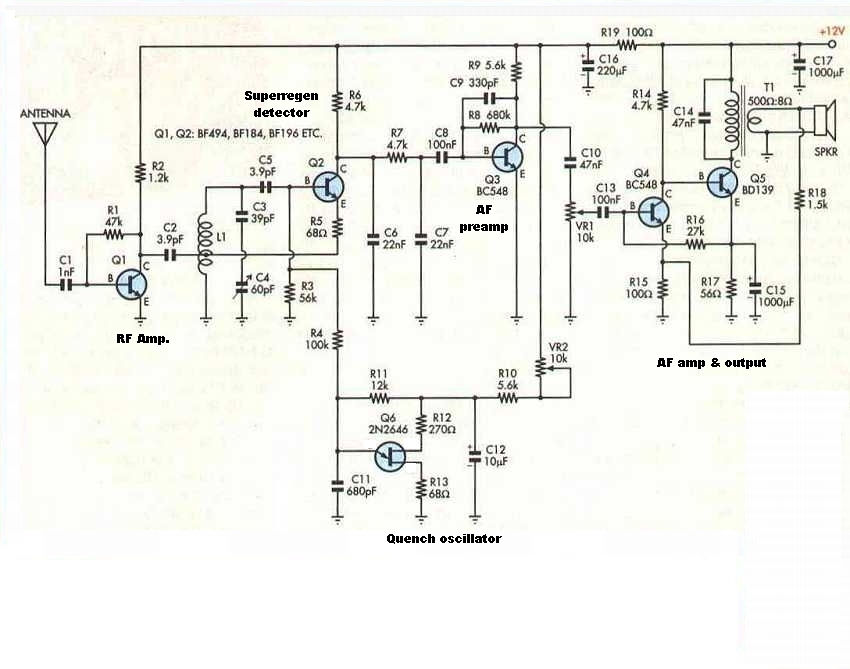
Circuit of the prototype (as presented in Silicon Chip) using an external aerial and a conventional tuning capacitor.
The following is a design for a separately
quenched super regen receiver I first tried in early 1992. It is
based on a circuit which appeared in Practical Wireless for July 1981.
It worked far better than any other solid state design, so I built a portable
version for use during my daily commuting on the train. Running off 10x
AA nicads, this gave me a week's listening before recharging.
My alterations to the PW circuit were
to include varicap tuning, an RF amplifier, and an audio amplifier.
I submitted my modified circuit to Silicon
Chip, whereupon it was published in the April 2003 issue.
My portable version differs in that it
uses varicap tuning, the output transformer has a 1K primary, and the output
transistor is a BC108, with bias components to suit. It also uses the headphone
lead for the aerial. There is no doubt that the separate quench feature
makes all the difference. Simple one transistor self quenched circuits
cannot match this design for sound quality or sensitivity.

Circuit of the prototype (as presented in Silicon Chip) using an
external aerial and a conventional tuning capacitor.
Circuit Description
This super-regenerative receiver is essentially
a VHF AM receiver, with slope detection used for FM. By tuning to one side
of the carrier, the receiver's tuned circuit converts FM to AM. The bandwidth
is about 200kHz so wideband FM stations can be demodulated by tuning the
receiver to the most linear point of the response curve, rather than the
top of the curve as one would for AM. In practice, this simply means tuning
for clearest sound.
The heart of the receiver is Q2 which
is a Hartley oscillator, with its tuned circuit in the base circuit. It
determines the frequency of oscillation and hence the receiving frequency.
RF amplifier Q1 is a self biased, untuned
common emitter amplifier, included to prevent aerial loading from affecting
the detector's oscillation frequency and amplitude. It also reduces any
RF radiated from the aerial. RF is coupled into the oscillator coil by
C2. The aerial can be a piece of wire cut to 75cm. A 75cm telescopic rod
aerial is better, but a proper outdoor FM aerial is preferred for non portable
use.
Most simple super-regenerative detectors
are self-quenched, however this makes it difficult to obtain the optimum
quench waveform. Particularly for wideband FM, the quench waveform has
considerable effect on sound quality.
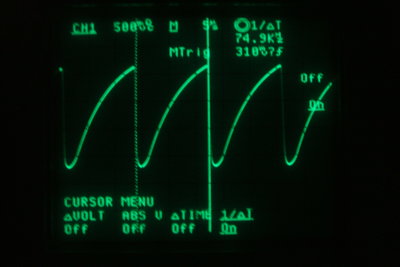
Quench waveform at the UJT emitter. The 74.9KHz quench frequency
shown here provides a good sound quality, but should be reduced if more
sensitivity is required.
In this receiver, the quenching of the
detector is achieved by Q6, a unijunction transistor (UJT) relaxation oscillator.
The emitter of the UJT provides an approximate sawtooth waveform, which
as it also provides the bias supply for Q2 takes the detector in and out
of oscillation at about 50kHz.
It is necessary to be able to set the
optimum quenching voltage and this is done by adjusting Q6's supply by
pot VR2. This effectively functions as the regeneration control.
Present at the collector of Q2 is the
demodulated AM or FM signal as well as the supersonic quench. This is of
sufficient amplitude to overload the following audio stages, so C6, R7,C7
and C9 provide simple low-pass filtering.
Transistors Q4 and Q5 form a class A amplifier,
which can provide about 80mW output. Bias stabilisation is automatic using
current feedback. If the current in Q5 rises then Q4 turns on harder, reducing
the bias for Q5. Negative feedback is obtained from the secondary of the
speaker transformer and fed into Q4 via R18. The windings of the transformer
must be phased correctly, otherwise the amplifier will oscillate. The transformer
is a standard transistor 500 ohm to 8 ohm output type.
The prototype receiver uses the local oscillator
section of a plastic AM radio tuning capacitor, which has a maximum capacitance
of about 60pF. To restrict the tuning range, a 39pF capacitor is
connected in series. (The aerial section of this variable capacitor tunes
a ZN414 AM receiver in the same enclosure, sharing the same audio amp).
The air-cored coil (L1) consists of four
turns of 18 gauge B&S tinned copper wire with 3/8" ID and tapped at
one turn. With this coil, frequency coverage is about 60-150MHz depending
on tuning capacitance.
As with all VHF circuitry, some care needs
to be taken with construction. The protoytpe was assembled on a piece of
blank PCB with the copper cut into small squares, to form isolated pads.
The portable version was built on a small piece of Veroboard.
The portable receiver runs from 10x 500mAh NiCd cells to provide 12V. Not shown is the charging circuit which is simply a 330R 1W resistor to provide a relatively constant charge current from a 30V power supply.
Operation.
When using this, or any other super-regenerative
receiver, it may be found that an audible tone is heard in the background
when listening to a station transmitting stereo or SCA programs. This is
a result of subcarriers beating with the quench frequency. Adjustment of
the quench frequency will usually minimise the problem.
With this receiver, if adjusting VR2 doesn't
get rid of it, then it's worth experimenting with C11. It's important to
note that raising the quench frequency too high will reduce receiver sensitivity.
Decreasing the quench frequency will improve sensitivity but the subcarrier
beat will be more evident. As SCA is now largely extinct, it is possible
these days to use a lower quench frequency around 35KHz.
Further decreasing quench frequency will
make the quench audible at all times. For non FM stereo/SCA applications,
C11 can be increased until just before the quench becomes audible.
Optimum sensitivity occurs with VR2 adjusted
to the point where the receiver has just gone into oscillation.
At this point, a "rushing" noise becomes
evident and stations can be tuned in. With very weak signals, it will become
obvious that the settings of VR2 and C4 interact slightly. I tested this
receiver with an HP8654B signal generator and could receive a 3uV signal,
albeit with some noise.
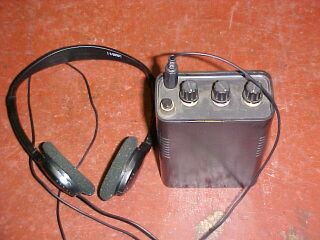
Portable version with headphone lead as the aerial.
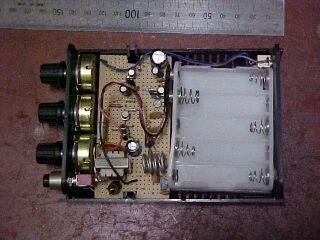
Note the three pots. The portable version uses varicap tuning. The
2.5mm socket at the rear is the 30V input for charging.
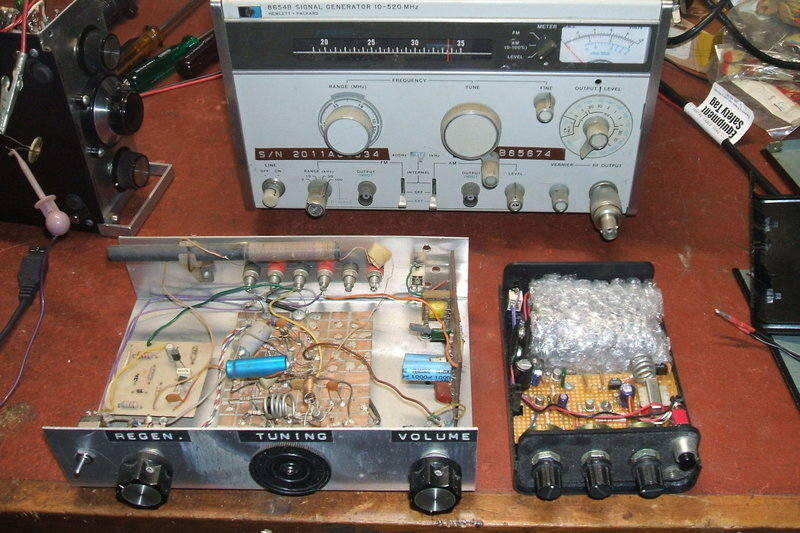
The prototype shown alongside the portable version. The small PCB
on the left is an MK484 receiver for Medium Waves, while the PCB on the
right is a two transistor audio amp. At rear is the HP8654B signal generator
used for testing sensitivity.
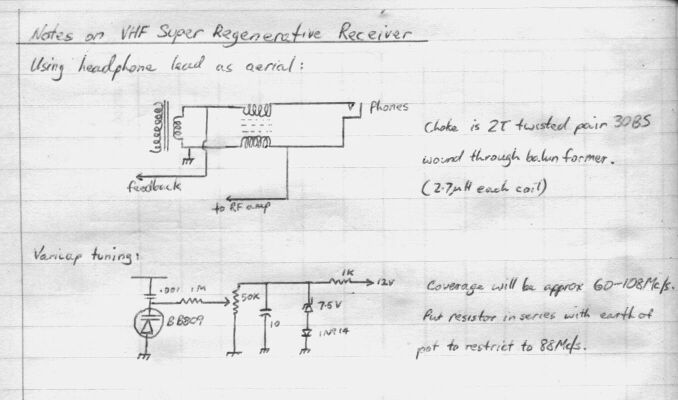
Taken from my original notes, this is how to use varicap tuning
and the headphone lead as an aerial. The 1N914 in series with the zener
diode provides temperature compensation.
Fellow FM enthusiast, Andy Mitz, who authored
the now defunct "somerset FM" site, decided to have a go at building this
receiver with a few minor changes.
The front end was kept as is, but an audio
amp IC replaced my two transistor circuit, and an 18V supply was used.
This is what Andy had to say: "I have attached some photos of
a regen build using much of your design. This version uses a Motorola varicap
diode and a Philips audio amp chip. The unit is sensitive (does not need
the whip antenna), selective, and has enough audio to overdrive the speaker."
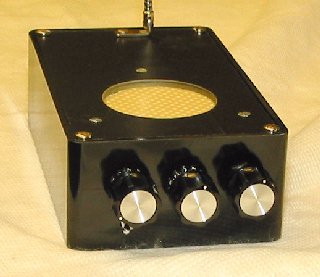
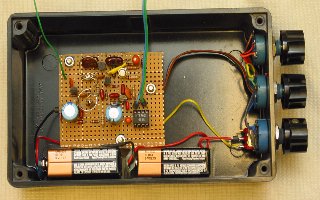
Inside and outside views of Andy's receiver.
The 18V supply would provide better
stability for the varicap tuner's zener
diode stabiliser as well as providing high audio output.
Here's
the circuit in .pdf.
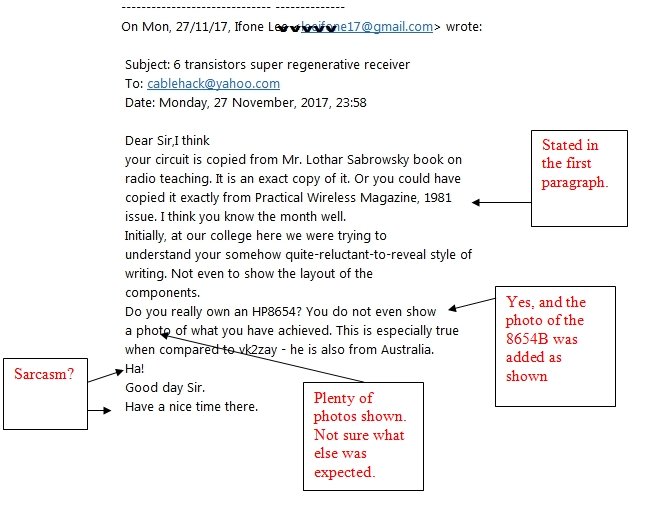
I don't think the author of this letter expected a reply, but I
did so - clearly showing the HP8654 signal generator. This article was
subsequently updated to show the signal generator along with the prototype
and final build, as shown above. Now to get pedandtic - the circuit is
based on the PW article, which I clearly state, but is not an "exact copy
of it". The audio amplifier is based on an Australian STC design from 1959,
which originally used germanium transistors, and was featured in a number
of "Radio Television & Hobbies", and later "Electronics Australia"
circuits. The RF amplifier is based on a circuit which appeared in the
Australian publication, Dick Smith's Funway Into Electronics, volume 1.
I am not sure what I was "reluctant-to-reveal". The operation of
the circuit is described, and all component values are given. As for showing
the layout of the components, that should be evident from the circuit.
I would suggest that the set is not suitable for those without prior construction
experience. "Do you really own an HP8654?". Yes, as a qualified RF technician,
the 8654 has been in possession since the commencement of my paid working
career starting in March of 1990. For any doubters of my work, just send
me an email, and I'll take a photo with your email user name handwritten
on a piece of paper against the relevant item. As for not showing "a photo
of what you have achieved", there are three photos of my construction,
and one of another constructor. VK2ZAY's site is completely independent
of this one and the relevance to it is not clear.